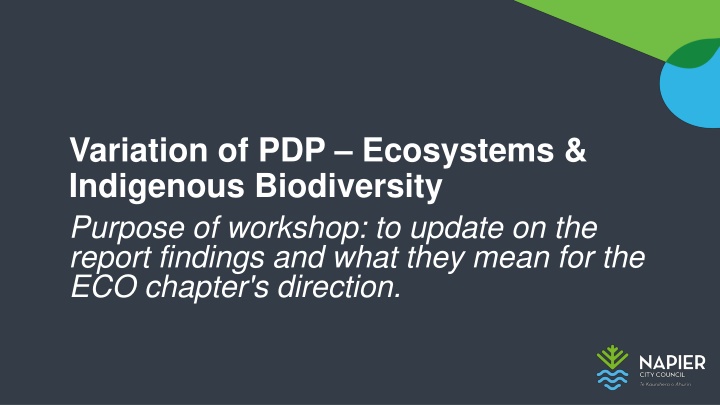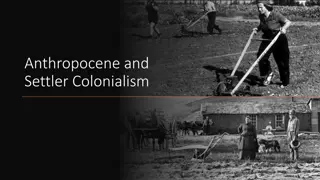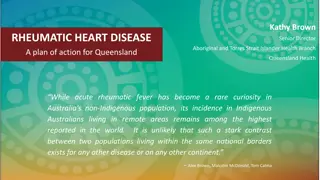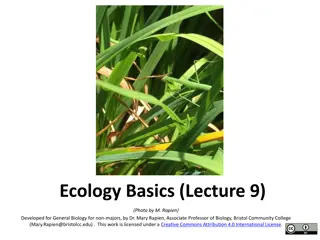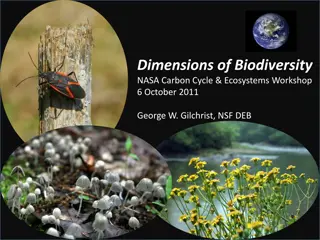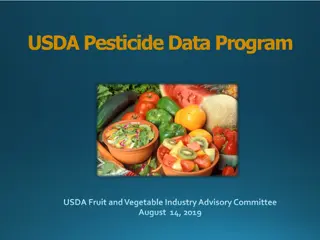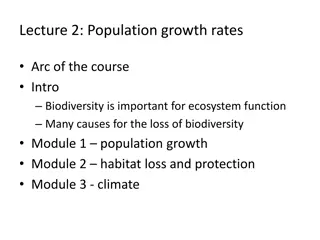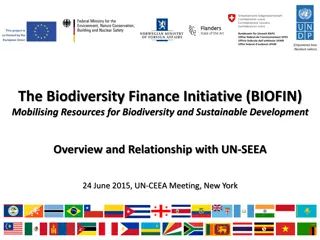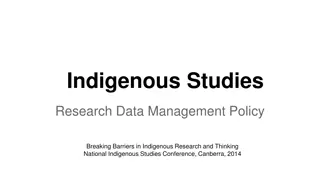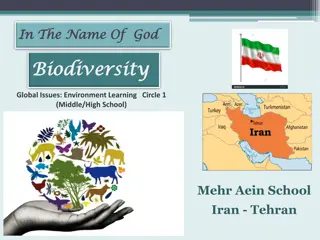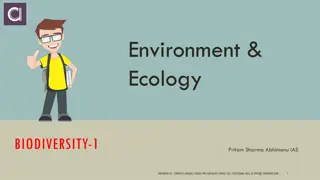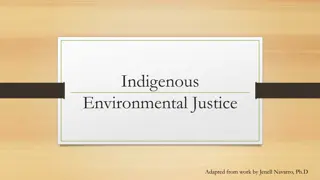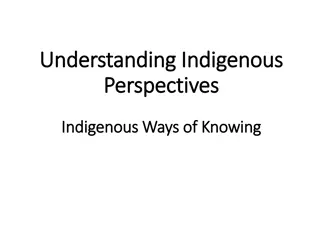Update on PDP Ecosystems & Indigenous Biodiversity Report Findings
Workshop update on depleted ecosystems, risks of loss, NPSIB alignment, SNA gaps, and policy approach for indigenous biodiversity protection in Napier.
Download Presentation

Please find below an Image/Link to download the presentation.
The content on the website is provided AS IS for your information and personal use only. It may not be sold, licensed, or shared on other websites without obtaining consent from the author.If you encounter any issues during the download, it is possible that the publisher has removed the file from their server.
You are allowed to download the files provided on this website for personal or commercial use, subject to the condition that they are used lawfully. All files are the property of their respective owners.
The content on the website is provided AS IS for your information and personal use only. It may not be sold, licensed, or shared on other websites without obtaining consent from the author.
E N D
Presentation Transcript
Variation of PDP Ecosystems & Indigenous Biodiversity Purpose of workshop: to update on the report findings and what they mean for the ECO chapter's direction.
Recap The Issue: Depleted ecosystems and indigenous biodiversity Without rules in place, IB Areas are not protected, high risk of loss Significant changes in Central Govt Context The National Policy Statement for Indigenous Biodiversity (NPSIB) was introduced in 2023. New central Govt signaled that the NPSIB might be removed or changed. Last decision of Council: Notify ECO as a variation to align with the NPSIB. Risk of reworking, however, landscape is changing with uncertainty - stay aligned with current guidelines for now. Where are we now: An ecologist reviewed the Council's SNA sites to ensure alignment with the NPSIB. Gaps were identified, including insufficient consideration of fauna. Categorisation of some sites might change
Mapped SNAs and Restoration Sites
Recap - Purpose of the Chapter Protection of Indigenous Biodiversity: The chapter safeguards Napier's rare and significant indigenous vegetation and habitats despite. Balance of Priorities: The ECO chapter balances protecting significant indigenous biodiversity while respecting private landowners' rights. Alignment with NPSIB: The chapter aligns with the NPSIB to identify, protect, and manage Significant Natural Areas (SNAs) in Napier.
The Policy Approach District-Wide Approach: Apply a consistent policy across Napier, with mapped sites reflecting uniform treatment. Objectives: Maintain and encourage indigenous biodiversity district-wide. Identify, preserve and connect biodiversity corridors for ecological function. Protect, maintain, and enhance biodiversity in Significant Natural Areas (SNAs). Precautionary Policies: Adopt a precautionary approach to ensure alignment with NPSIB and prioritise biodiversity protection.
The Policy Approach NPSIB requirements to involve tangata whenua in policy creation & decision-making NPSIB directives management of subdivision and use of land, carve-outs (eg specified infrastructure, single res dwelling on existing site) Specified M ori Land Identification & protection of taonga species to be addressed in a future plan change
Option 1: Status Quo Description Risks Benefits - Lack of Protection: No specific provisions mean no targeted protection for significant sites. - Non-Compliance Risk: Risk of not meeting NPS-IB requirements. - Missed Opportunities: Fails to leverage potential improvements for biodiversity. - Potential Future Costs: Higher costs later for compliance or remedial actions. - Simplicity: No need for immediate changes or updates. - Landowners: Avoids upsetting affected landowners Maintain Current Approach: Keep existing provisions (no specific provisions in the operative plan).
Option 2: Implement Draft DP Description Risks Benefits - Compliance with NPS-IB: Aligns with national standards and demonstrates commitment to biodiversity. - Community Pushback: Potential resistance from stakeholders or landowners. Keep All 32 Sites as SNAs: Retain all 32 sites as Significant Natural Areas (SNAs) and manage under s6 of the RMA. - Comprehensive Coverage: Broad protection of significant sites.
Option 3: Bespoke Place-based Approach Description Risks Benefits Site-Specific Classifications: Classify selected sites, including some ecological corridors owned by NCC, based on ecologist recommendations. - Site-specific Classification: Not best policy practice. -Does not give effect to NPSIB - Increased SNA Coverage: Including NCC- owned ECs helps contribute to the SNA threshold. - Landowners aligns with landowners interests Incentivise Protection: Allows working with residents to incentivise protection of sites using non-District Plan methods. - Tailored Approach: Provides specific management solutions suited to owners unique needs. - Covenant Enforcement: Risk of loss if the covenant is not enforced; weaker protection unless with QEII Trust or NCC Reserves. - Potential loss of biodiversity: difficult for Council to keep track of loss of biodiversity - Potential costs to Council of incentives -Does not give effect to NPSIB & s.6 RMA Private Owner Specific Overlay: Assign a separate classification with management through a Reserve Management Plan, incentives, and private covenant, avoiding District Plan rules. Remaining biodiversity management: Maintain an "Encourage/Enhance" policy for the remaining ecological corridors and biodiversity. - Variable Protection: Not strong policy approach to meet biodiversity goals. - Does not align with NPSIB - Flexible Management: Promotes biodiversity while accommodating various land use activities.
Option 4: Tiered Approach Description Risks Benefits - Community Dissatisfaction: Resistance from Private Landowners, could lead to non-compliance. - Reduced SNA Coverage (from Draft): Lower NCC s total SNA coverage, moving further from the 10% threshold. Protect All SNA Sites: Maintain a "Protect" policy/objective for all 16 sites identified with NPS-IB or Section 6 criteria. - NPSIB Compliance: Meets NPSIB criteria, protecting NCC's indigenous biodiversity cover. We currently have no protection. - Balanced Approach: Allows for some flexibility in land use while still promoting biodiversity. - NPSIB compliance Restoration sites (Ecological Corridors & buffers): Manage 17 restoration sites that do not meet Section 6 criteria with an "Encourage/Enhance" policy/objective. - Community Resistance: Potential for dissatisfaction due to differing management approaches.
Developing Preferred Option: Tiered Approach Moderate Restriction: Ecological Corridors Least Restrictive: District Wide Biodiversity Areas Most Restrictive: SNAs
Developing Preferred Option Align activities with conservation objectives, minimise impacts, and enhance biodiversity, enable activities where required by NPSIB. Activity Trimming, Pruning, and Maintenance District-wide Biodiversity Areas Ecological Corridors Significant Natural Areas (SNAs) No RC (when standards met) No RC (when standards met) RC Needed RC Needed RC Needed RC Needed (NC) Removal or Clearance RC Needed RC Needed RC Needed (NC) Earthworks RC Needed (NC) No RC (when standards met) RC Needed Plantation Forestry No RC (when standards met) RC Needed RC Needed (NC) Agricultural Intensification RC Needed RC Needed Prohibited Quarrying or Mining Activities Exemptions (eg Specified Infrastructure, H & S) RC Needed RC Needed RC Needed ? ? ? Specified M ori land
Next Steps Engagement In discussion with Esk Hills Resident Society (Appetite for formal pre-engagement?) Mana whenua (Specified M ori Land) Preparation of Notification Docs in early November (Mapping, S32 Report, Public Notices) Endorsement to go public with the Variation Submission Period late November early December (optimistic)
